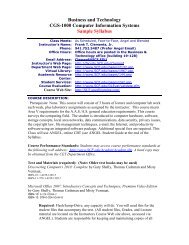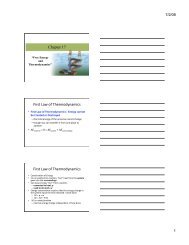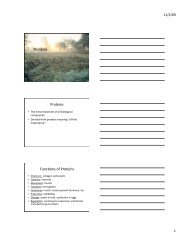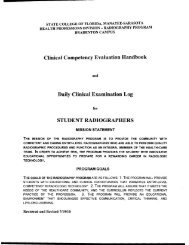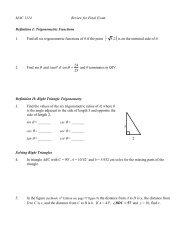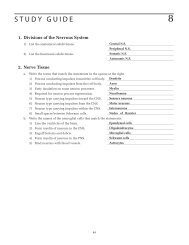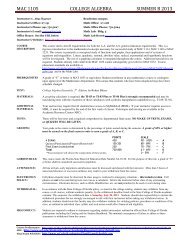Chemical Equilibrium - Scf
Chemical Equilibrium - Scf
Chemical Equilibrium - Scf
You also want an ePaper? Increase the reach of your titles
YUMPU automatically turns print PDFs into web optimized ePapers that Google loves.
“<strong>Chemical</strong><br />
<strong>Equilibrium</strong>”<br />
Chapter 14<br />
Hemoglobin<br />
• Hemoglobin is a protein (Hb) found in<br />
red blood cells that reacts with O 2<br />
– enhances the amount of O 2 that can be<br />
carried through the blood stream<br />
Hb + O 2 ⇔ HbO 2<br />
– the Hb represents the entire protein – it is<br />
not a chemical formula<br />
– the ⇔ represents that the reaction is in<br />
dynamic equilibrium<br />
Hemoglobin<br />
• The concentrations of Hb, O 2 , and HbO 2 are<br />
all interdependent<br />
• The relative amounts of Hb, O 2 , and HbO 2 at<br />
equilibrium are related to a constant called<br />
the equilibrium constant, K<br />
• Changing the concentration of any one of<br />
these necessitates changing the other<br />
concentrations to reestablish equilibrium<br />
1
In the lungs, with high<br />
concentration of O 2 ,<br />
the equilibrium shifts<br />
to combine the Hb and<br />
O 2 together to make<br />
more HbO 2<br />
Hemoglobin<br />
In the cells, with low<br />
concentration of O 2 ,<br />
the equilibrium shifts<br />
to break down the<br />
HbO 2 and increase the<br />
amount of free O 2<br />
Fetal Hemoglobin<br />
Fetal hemoglobin’s<br />
equilibrium constant is<br />
larger than adult<br />
hemoglobin<br />
Because fetal hemoglobin<br />
is more efficient at<br />
binding O 2, O 2 is<br />
transferred to the fetal<br />
hemoglobin from the<br />
mother’s hemoglobin in<br />
the placenta<br />
Reactions<br />
• When a reaction starts, the reactants are consumed and<br />
products are made<br />
– In the forward reaction = reactants → products<br />
– reactant concentrations decrease and the product<br />
concentrations increase as reactant concentration<br />
decreases, the forward reaction rate decreases<br />
• Eventually, the products can react to reform some of the<br />
reactants<br />
– In the reverse reaction = products → reactants<br />
– assuming the products are not allowed to escape as product<br />
concentration increases, the reverse reaction rate increases<br />
• Processes that proceed in both the forward and reverse<br />
direction are said to be reversible<br />
– reactants ⇔ products<br />
2
Dynamic <strong>Equilibrium</strong><br />
• As the forward reaction slows and the<br />
reverse reaction accelerates, eventually<br />
they reach the same rate<br />
• Dynamic equilibrium is the condition<br />
where the rates of the forward and reverse<br />
reactions are equal<br />
• Once the reaction reaches equilibrium, the<br />
concentrations of all the chemicals remain<br />
constant<br />
<strong>Equilibrium</strong> ≠ Equal<br />
• The rates of the forward and reverse<br />
reactions are equal at equilibrium<br />
• That does not mean the concentrations of<br />
reactants and products are equal<br />
– Some reactions reach equilibrium only after almost<br />
all the reactant molecules are consumed – we say<br />
the position of equilibrium favors the products<br />
– Other reactions reach equilibrium when only a<br />
small percentage of the reactant molecules are<br />
consumed – we say the position of equilibrium<br />
favors the reactants<br />
An Analogy: Population<br />
Changes<br />
3
<strong>Equilibrium</strong> Constant<br />
• Even though the concentrations of reactants and<br />
products are not equal at equilibrium, there is a<br />
relationship between them<br />
• the relationship between the chemical equation<br />
and the concentrations of reactants and products<br />
can be seen in the <strong>Equilibrium</strong> Expression<br />
• Consider: aA + bB ⇔ cC + dD<br />
– the lowercase letters represent the coefficients of the<br />
balanced chemical equation<br />
• K is called the equilibrium constant is equal to the<br />
product concentration raised to their coefficient<br />
over the reactants raised to their coeffcients K is<br />
unitless<br />
Writing <strong>Equilibrium</strong> Constant<br />
Expressions<br />
• For the reaction<br />
• aA (aq) + bB (aq) ⇔ cC (aq) + dD (aq) the<br />
equilibrium constant expression is<br />
• For the reaction<br />
2 N 2O 5 ⇔ 4 NO 2 + O 2 the<br />
equilibrium constant<br />
expression is:<br />
What Does the Value of K eq<br />
Imply?<br />
• When the value of K eq >> 1, we know that<br />
when the reaction reaches equilibrium there<br />
will be many more product molecules present<br />
than reactant molecules<br />
• When the value of K eq
Large K<br />
Small K<br />
<strong>Equilibrium</strong> Constants for<br />
Reactions Involving Gases<br />
• The concentration of a gas in a mixture is<br />
proportional to its partial pressure<br />
• Therefore, the equilibrium constant can be expressed<br />
as the ratio of the partial pressures of the gases<br />
• For aA(g) + bB(g) ⇔ cC(g) + dD(g) the equilibrium<br />
constant expressions are<br />
5
K c and K p<br />
• In calculating K p, the partial pressures are always in<br />
atm<br />
• The values of K p and K c are not necessarily the same<br />
– because of the difference in units<br />
– K p = K c when Δn = 0<br />
• The relationship between them is: K p = K c (RT) Δn<br />
Example<br />
Heterogeneous Equilibria<br />
• Pure solids and pure liquids are materials<br />
whose concentration doesn’t change during<br />
the course of a reaction<br />
• Because their concentration doesn’t change,<br />
solids and liquids are not included in the<br />
equilibrium constant expression<br />
– the reaction aA(s) + bB(aq) ⇔ cC(l) + dD(aq)<br />
– the equilibrium constant expression is:<br />
6
Heterogeneous Equilibria<br />
Calculating <strong>Equilibrium</strong> Constants from<br />
Measured <strong>Equilibrium</strong> Concentrations<br />
• The most direct way of finding the equilibrium<br />
constant is to measure the amounts of<br />
reactants and products in a mixture at<br />
equilibrium<br />
• The equilibrium mixture may have different<br />
amounts of reactants and products, but the<br />
value of the equilibrium constant will always<br />
be the same<br />
– as long as the temperature is kept constant<br />
Calculating <strong>Equilibrium</strong><br />
Concentrations<br />
• Stoichiometry can be used to determine the<br />
equilibrium concentrations of all reactants and<br />
products if you know initial concentrations<br />
and one equilibrium concentration<br />
– suppose you have a reaction 2 A (aq) + B (aq) ⇔ 4 C (aq) with<br />
initial concentrations [A] = 1.00 M, [B] = 1.00 M, and [C] = 0.<br />
You then measure the equilibrium concentration of C as [C]<br />
= 0.50 M.<br />
7
Example<br />
The Reaction Quotient<br />
• If a reaction mixture, containing both reactants and<br />
products, is not at equilibrium; how can we determine<br />
which direction it will proceed?<br />
• The answer is to compare the current concentration<br />
ratios to the equilibrium constant<br />
• The concentration ratio of the products (raised to the<br />
power of their coefficients) to the reactants (raised to<br />
the power of their coefficients) is called the reaction<br />
quotient, Q (a snapshot of the reaction)<br />
The Reaction Quotient:<br />
Predicting the Direction of Change<br />
• Q > K, the reaction will proceed fastest in the reverse<br />
direction<br />
• Q < K, the reaction will proceed fastest in the forward<br />
direction<br />
• Q = K, the reaction is at equilibrium<br />
• Note:<br />
– if a reaction mixture contains just reactants, Q = 0, and the<br />
reaction will proceed in the forward direction<br />
– if a reaction mixture contains just products, Q = ∞, and the<br />
reaction will proceed in the reverse direction<br />
8
Example<br />
• A sample of PCl 5(g) is placed in a 0.500 L container<br />
and heated to 160°C. The PCl 5 is decomposed into<br />
PCl 3(g) and Cl 2(g). At equilibrium, 0.203 moles of<br />
PCl 3 and Cl 2 are formed. Determine the equilibrium<br />
concentration of PCl 5 if K c = 0.0635<br />
Finding <strong>Equilibrium</strong> Concentrations When<br />
Given the <strong>Equilibrium</strong> Constant and Initial<br />
Concentrations or Pressures<br />
• First decide which direction the reaction will<br />
proceed<br />
– compare Q to K<br />
• Define the changes of all materials in terms of x<br />
• Solve for x<br />
9
Example<br />
• For the reaction I 2 (g) ⇔ 2 I(g) the value of<br />
K c = 3.76 x 10 -5 at 1000 K. If 1.00 moles of I 2 is placed into a<br />
2.00 L flask and heated, what will be the equilibrium<br />
concentrations of [I 2 ] and [I]?<br />
(Hint: you will need to use the quadratic formula to solve for x)<br />
Approximations to Simplify the Math<br />
• When the equilibrium constant is very small,<br />
the position of equilibrium favors the<br />
reactants<br />
• For relatively large initial concentrations of<br />
reactants, the reactant concentration will not<br />
change significantly when it reaches<br />
equilibrium<br />
– the [X] equilibrium = ([X] initial − ax) ≈ [X] initial<br />
– assuming the reaction is proceeding forward<br />
Checking the Approximation and<br />
Refining as Necessary<br />
• We can check our approximation<br />
afterwards by comparing the<br />
approximate value of x to the initial<br />
concentration<br />
• If the approximate value of x is less<br />
than 5% of the initial concentration, the<br />
approximation is valid<br />
10
Example<br />
• For the reaction 2 H 2 S(g) ⇔ 2 H 2 (g) + S 2 (g) @ 800°C, K c = 1.67<br />
x 10 -7 . If a 0.500 L flask initially containing 1.25 x 10 -4 mol H 2S<br />
is heated to 800°C, find the equilibrium concentrations.<br />
Disturbing and Re-establishing<br />
<strong>Equilibrium</strong><br />
• Once a reaction is at equilibrium, the<br />
concentrations of all the reactants and<br />
products remain the same<br />
• However if the conditions are changed, the<br />
concentrations of all the chemicals will<br />
change until equilibrium is re-established<br />
• The new concentrations will be different, but<br />
the equilibrium constant will be the same<br />
– unless you change the temperature<br />
Le Châtelier’s Principle<br />
• Le Châtelier's Principle guides us in<br />
predicting the effect various changes in<br />
conditions have on the position of equilibrium<br />
• It says that if a system at equilibrium is<br />
disturbed, the position of equilibrium will shift<br />
to minimize the disturbance<br />
– disturbances all involve making the system open<br />
11
Le Châtelier’s Principle<br />
• Think of this principle in term of a<br />
push/pull stress.<br />
• Whatever you do to a reaction can have<br />
one of four possible outcomes:<br />
– Shift product<br />
– Shift reactant<br />
– No Shift<br />
– Cannot be determine<br />
Le Châtelier’s Principle<br />
(Concentration Stress)<br />
Type of Stress<br />
Increase reactants or<br />
decrease products<br />
Decrease reactants or<br />
increase products<br />
Result<br />
Shift to the product<br />
side<br />
Shift to the reactant<br />
side<br />
Le Châtelier’s Principle<br />
(Pressure/Volume Stress)<br />
Type of Stress<br />
Decrease pressure or<br />
increase volume<br />
Increase pressure or<br />
decrease volume<br />
Result<br />
Shift to the side with<br />
more gas particles<br />
Shift to the side with<br />
fewer gas particles<br />
Note: This is only for reactions involving gasses (if no<br />
gas or equal moles of gas then no shift occurs)<br />
12
Type of Stress<br />
Le Châtelier’s Principle<br />
(Temperature Stress)<br />
Increase Temperature<br />
Decrease Temperature<br />
Result<br />
Shift in the endothermic<br />
direction<br />
Shift in the exothermic<br />
direction<br />
Note: You must know whether the reaction is<br />
exothermic or endothermic (If you do not know the<br />
energy exchange involved in a reaction then the shift<br />
cannot be determined)<br />
Using Le Châtelier’s Principle<br />
Example<br />
• The reaction 2 SO 2(g) + O 2(g) ⇔ 2 SO 3(g) with ΔH° = -198<br />
kJ is at equilibrium.<br />
– adding more O 2 to the container<br />
– condensing and removing SO 3<br />
– compressing the gases<br />
– cooling the container<br />
– doubling the volume of the container<br />
– warming the mixture<br />
– adding the inert gas helium to the container<br />
– adding a catalyst to the mixture<br />
13





